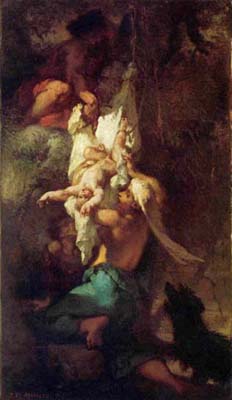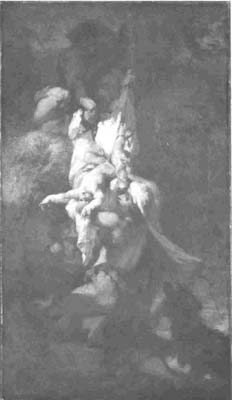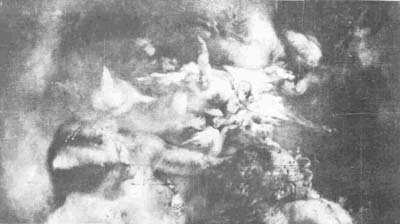
Bulletin 24, 1974
Home
Français
Introduction
History
Annual Index
Author &
Subject
Credits
Contact



Millet's
"Saint Jerome Tempted" and
"Oedipus Taken Down from the Tree":
The Discovery of
a Lost Painting
by Bruce Laughton
Résumé en français
Pages 1 | 2 |
3 | 4
| 5 | 6
When impecunious art students paint over old studies to save canvas, the result is seldom
a brilliantly luminous surface; when a major artist cuts up a major work
and paints over that, the loss is an art-historical disaster, and the new
painting can present hill with some technical problems. This may be said
to be the case with Jean-François Millet's Saint Jerome Tempted,
a substantial part of which lies beneath his painting of Oedipus
Taken Down from the Tree (figs I and 2). The National Gallery of Canada
thus possesses two major paintings by Millet, one on top of the other.
This is revealed by their brilliant series of X-rays taken in 1972. When
the X-ray reconstruction is turned 90 degrees clockwise, the head of Saint
Jerome being grasped by a young woman will be seen. The story of both pictures is the subject of this article.
Until its recent cleaning by the National Gallery, (1) the dense
obscurity of some are as of the paint surface of Oedipus used to
be somewhat puzzling. Its overall appearance was almost as dark as that of
Daumier's masterpiece The Third Class Railway Carriage which
hung near it, although when looked at closely some vigorous brushwork
could be discerned beneath the varnish. Now that this has been removed,
the general greenish tone has disappeared, and the very thickly impasted
areas are revealed to be brilliantly coloured. The naked child, formerly
yellowish, now stands out against the white cloth in subtly modulated colours,
including a ruddy pink, and what appeared to be a brownish half-tone headdress
on the kneeling shepherdess is now so blonde in the highlights that it
may be read as long hair streaming out behind her. A considerable degree
of colour variation is visible in separate strokes, although in places
the paint is applied so thickly as to merit the appellation coarse. The
tonal contrast between light and dark areas remains considerable, but
the colour revealed in the shadows is almost Venetian in character. For
example, the shepherd crouched above the great knotted 'wart' of the
tree-trunk is rendered in warm reds which do not lose their colour-values
by being low-toned. Particularly striking are the separate strokes of red
over a green base on the shepherd's nearest hand, the nervous, pointed
fingers of which are reminiscent of Tintoretto. Was this how the painting
originally appeared? We shall consider some contemporary comments shortly.
The Saint Jerome which lies beneath - one might say beaten
beneath - will never be seen again, except in the narrow strip on the fold-over
of the cut down canvas, (2) where the flesh tones of the saint's shoulder
and arm, and the woman's chest, remain visible where we would expect to
find them after studying the X-ray (fig. 2). The story of this painting,
which may have been equally brilliant in execution, will be considered first.
Early in 1846, when Millet was working in Paris, he received a letter from his grandmother, Mme Veuve Jumelin, the doyenne of his
family at Gréville on the Normandy coast, and effectively his spiritual
guardian:
A Gréville, le 10 janvier 1846.
...Tu nous dis que tu vas travailler à faire le portrait
de saint Jérôme, gémissant sur les dangers où
il s'était trouvé exposé dans sa jeunesse. Ah! mon
cher enfant, à son exemple, fais les mêmes réflexions
et en tire un saint profit. Suis l'exemple de cet homme de ton état
qui disait: « ]e peins pour l'eternité ». Pour quelque
raison que ce puisse être, ne te permets jamais de faire de mauvais
ouvrages. Ne perds pas la présence de Dieu; avec saint Jérôme,
pense incessemment entendre la trompette qui doit nous appeler au Jugement... (3)
This letter is full of personal overtones. The was then aged thirty-one. He had
first wife, Pauline Ono of Cherbourg, less
years previously in tragic circumstances, when
were living precariously in Paris. Not many months later he had formed
a liaison with another local girl in Gréville, Catherine Lemaire,
whom he would eventually marry after the birth of their fourth child.
This liaison created strained relationships with the rest of the family,
as may be deduced by the young couple's flight to Le Havre, where they
stayed for a large part of 1845. (It may be worth noting that both Millet's
wives were very young women when he first met them, and that he himself
had a passionate nature.) (4)
At this time Millet was painting portraits,
pastoral and mythological scenes, including nudes. An exhibition in Le
Havre realized enough money to go back to Paris in December, whereupon
Millet set about planning a large-scale work to send to the Salon in
May 1846. He was to become, before his Barbizon period, a most proficient
and sensitive painter of nudes (one of the most widely known examples is
the small Nue endormie now in the Louvre Museum, which has something
of the tonality and colouristic qualities of Titian). Plainly his aim was to
present himself to the Salon jury with an 'important' large work, already achieved
modest success with two pictures of pastoral subjects in 1844. An analagous situation
would be that of Thomas Couture, at one time a fellow - student of Millet's in the
atelier of Delarouche, who in the following year, 1847 exhibited at the Salon his
Decadence of the Romans (Louvre), a very large canvas setting with nudes which
absolutely established his future career. Millet's Saint Jerome, however, was rejected, and he cut it up.
As far as possible, we would now like to reconstruct the picture. Alfred
Sensier, Millet's first biographer, describes it thus:
Son Saint Jérôme cherche à se dégager
des caresses féminines et crie malédiction contre les filles
de Satan. Une d'elles étreint le solitaire dans l'ardeur d'un brûlant
baiser. Millet, le pinceau à la main, allait quelquefois
jusqu'au bout de la passion sic). Cette peinture,
très juste d'effet et de mouvement, était d'une exécution
superbe; Couture admirait et envoyait les artistes voirce morceau étonnant.
(5)
Next Page | Millet
1 | 2 |
3 | 4
| 5 | 6
Annual Index | Author & Subject | Credits | Contact
This digital collection
was produced under contract to Canada's Digital Collections program,
Industry Canada.
"Digital
Collections Program, Copyright
© National Gallery of
Canada 2001"